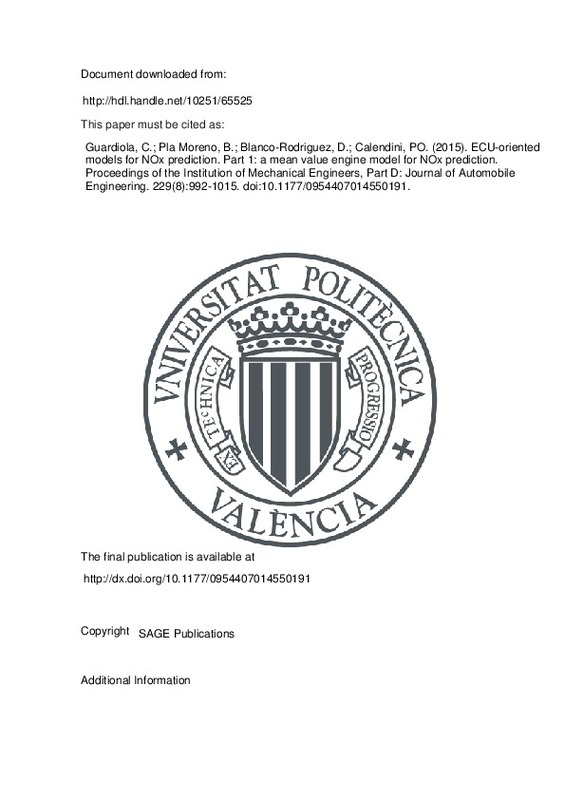JavaScript is disabled for your browser. Some features of this site may not work without it.
Buscar en RiuNet
Listar
Mi cuenta
Estadísticas
Ayuda RiuNet
Admin. UPV
ECU-oriented models for NOx prediction. Part 1: a mean value engine model for NOx prediction
Mostrar el registro sencillo del ítem
Ficheros en el ítem
| dc.contributor.author | Guardiola, Carlos
|
es_ES |
| dc.contributor.author | Plá Moreno, Benjamín
|
es_ES |
| dc.contributor.author | Blanco-Rodriguez, David
|
es_ES |
| dc.contributor.author | Calendini, Pierre Olivier
|
es_ES |
| dc.date.accessioned | 2016-06-08T12:39:12Z | |
| dc.date.available | 2016-06-08T12:39:12Z | |
| dc.date.issued | 2015-07 | |
| dc.identifier.issn | 0954-4070 | |
| dc.identifier.uri | http://hdl.handle.net/10251/65525 | |
| dc.description.abstract | The implantation of nitrogen oxide sensors in diesel engines was proposed in order to track the emissions at the engine exhaust, with applications to the control and diagnosis of the after-treatment devices. However, the use of models is still necessary since the output from these sensors is delayed and filtered. The present paper deals with the problem of nitrogen oxide estimation in turbocharged diesel engines combining the information provided by both models and sensors. In Part 1 of this paper, a control-oriented nitrogen oxide model is designed. The model is based on the mapping of the nitrogen oxide output and a set of corrections which account for the variations in the intake and ambient conditions, and it is designed for implementation in commercial electronic control units. The model is sensitive to variations in the engine's air path, which is solved through the engine volumetric efficiency and the first-principle equations but disregards the effect of variation in the injection settings. In order to consider the effect of the thermal transients on the in-cylinder temperature, the model introduces a dynamic factor. The model behaves well in both steady-state operation and transient operation, achieving a mean average error of 7% in the steady state and lower than 10% in an exigent sportive driving mountain profile cycle. The relatively low calibration effort and the model accuracy show the feasibility of the model for exhaust gas recirculation control as well as onboard diagnosis of the nitrogen oxide emissions. | es_ES |
| dc.language | Inglés | es_ES |
| dc.publisher | SAGE Publications | es_ES |
| dc.relation.ispartof | Proceedings of the Institution of Mechanical Engineers, Part D: Journal of Automobile Engineering | es_ES |
| dc.rights | Reserva de todos los derechos | es_ES |
| dc.subject | Nitrogen oxide model | es_ES |
| dc.subject | look-up tables | es_ES |
| dc.subject | diesel engine | es_ES |
| dc.subject | nitrogen oxide sensor | es_ES |
| dc.subject | control | es_ES |
| dc.subject.classification | INGENIERIA AEROESPACIAL | es_ES |
| dc.subject.classification | MAQUINAS Y MOTORES TERMICOS | es_ES |
| dc.title | ECU-oriented models for NOx prediction. Part 1: a mean value engine model for NOx prediction | es_ES |
| dc.type | Artículo | es_ES |
| dc.identifier.doi | 10.1177/0954407014550191 | |
| dc.rights.accessRights | Abierto | es_ES |
| dc.contributor.affiliation | Universitat Politècnica de València. Departamento de Máquinas y Motores Térmicos - Departament de Màquines i Motors Tèrmics | es_ES |
| dc.contributor.affiliation | Universitat Politècnica de València. Instituto Universitario CMT-Motores Térmicos - Institut Universitari CMT-Motors Tèrmics | es_ES |
| dc.description.bibliographicCitation | Guardiola, C.; Pla Moreno, B.; Blanco-Rodriguez, D.; Calendini, PO. (2015). ECU-oriented models for NOx prediction. Part 1: a mean value engine model for NOx prediction. Proceedings of the Institution of Mechanical Engineers, Part D: Journal of Automobile Engineering. 229(8):992-1015. doi:10.1177/0954407014550191 | es_ES |
| dc.description.accrualMethod | S | es_ES |
| dc.relation.publisherversion | http://dx.doi.org/10.1177/0954407014550191 | es_ES |
| dc.description.upvformatpinicio | 992 | es_ES |
| dc.description.upvformatpfin | 1015 | es_ES |
| dc.type.version | info:eu-repo/semantics/publishedVersion | es_ES |
| dc.description.volume | 229 | es_ES |
| dc.description.issue | 8 | es_ES |
| dc.relation.senia | 304526 | es_ES |
| dc.identifier.eissn | 2041-2991 |







![[Cerrado]](/themes/UPV/images/candado.png)

